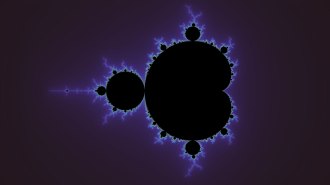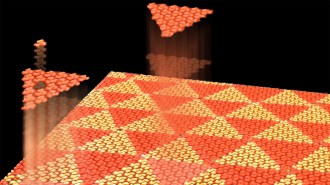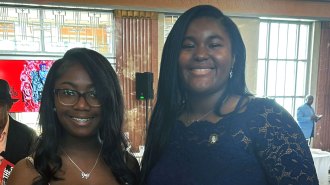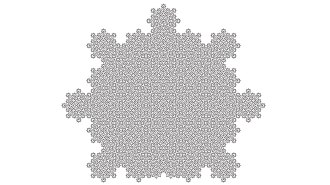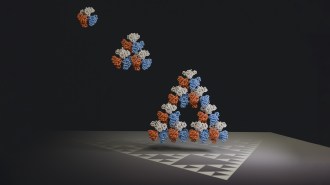The television game show Who Wants to Be a Millionaire regularly attracts a huge audience. Can a mathematical game show hold its own against such competition–especially without lifelines, dramatic lighting effects, precarious chairs for contestants, and Regis Philbin as host? Probably not, but it can still be great fun.
More than 200 mathematicians and students showed up on a Thursday evening to participate in The Number Years, a featured event at the Joint Mathematics Meetings held earlier this month in Washington, D.C. It was organized by Jennifer J. Quinn of Occidental College in Los Angeles, who also served as emcee, along with Eric J. Libicki of the University of Southern California and Arthur T. Benjamin of Harvey Mudd College.
Originally created by Libicki, The Number Years started out as a classroom activity designed to bring a sense of fun to learning the history of mathematics. It gradually evolved into a game-show format and now has its own Web site at http://www.jquinn.oxy.edu/numberyears/. Visitors can try out the sample game developed for the January event.
The goal is to build up a database of mathematical game-show questions that instructors can tailor for use in their own classrooms, Quinn says.
The whole audience participated in Round 1, which involved 15 multiple-choice questions.
I’ve adapted some of those questions for the following quiz. Remember that, like typical game-show contestants, you shouldn’t count on a calculator or the Web to help you out. So, let’s play The Math Game.
- Digitopolis can be found
- in the book The Phantom Tollbooth.
- in the movie The Phantom Menace.
- in the musical The Phantom of the Opera.
- 25 miles northwest of Phantom Mines, Nevada.
- California will celebrate its sesquicentennial anniversary as a state in the year 2000. In what year did or will California celebrate its quinquennial anniversary?
- 1855
- 1900
- 2350
- 6850
- Edwin A. Abbott wrote Flatland in 1884. About 60 years later, Dionys Burger wrote a sequel. What was its title?
- Mathland
- Sphereland
- Spaceland
- Tomorrowland
- Who first proved L’Hpital’s rule?
- Guillaume de L’Hpital
- Johann Bernoulli
- Daniel Bernoulli
- Julie Bernoulli
- Which one of the following area codes is a prime number?
- 907 (Alaska)
- 817 (North central Texas)
- 671 (Guam)
- 202 (District of Columbia)
- Which one of the following cities has NOT recognized the importance of Euclid’s contribution to mathematics by naming a street after him?
- Chicago, Illinois
- Flagstaff, Arizona
- Pasadena, California
- Providence, Rhode Island
- Which one of the following zip codes equals 8!?
- Grant, Alabama
- Ford, Kentucky
- Lincoln, Nebraska
- Walla Walla, Washington
- According to a standard dictionary of the English language, which one of the following mathematical terms also means “a stony mass or deposit formed in the body”?
- matrix
- sine
- calculus
- digit
- According to the Dewey Decimal System for cataloguing library books, In which one of the following number ranges would you find a book on general mathematics?
- 130-139
- 160-169
- 310-319
- 510-519
- Which one of the following numbers is closest to 2?
- Ö2
- p
- f, or (1 + Ö5)/2
- ln(2)
How did you do? [Answers]
At the math meeting contest, the top dozen scorers were invited to “come on down” to play Round 2.
In Round 2, the contestants faced a grid of categories and question values (1, 2, or 3 points) like that seen on the TV game show Jeopardy. The categories were “Foreign Relations,” “Name that Number,” “Mathematicians I’ve Known,” “D.C.,” and “Value Judgements.” I particularly liked “Value Judgements,” where contestants had to look at a mathematical expression and decide whether its value is positive, negative, or zero.
- pe – ep (1 point)
- 1 – epi (2 points)
- Fn + 2 – (F0 + F1 + F2 + . . . + Fn – 1 + Fn), where F0 = 0, F1 = 1, and Fn = Fn – 1 + Fn – 2 (3 points)
Three finalists were then invited to play a word puzzle game reminiscent of the final round in the game show Wheel of Fortune. Contestants take turns selecting a letter of the alphabet (including vowels) to see if it shows up in any blank squares representing a mathematical phrase or quotation, then try to guess the phrase.
Here’s how one puzzle went. Can you guess the answer before a contestant did?
_ _ _ __ _ _ _ __ _ _ _ _ _ _ __ __ _ _ _
T:_ _ _ _T _ _ _ __ _ _ T _ _ _ __ __ _ _ _
R:_ _ R _T _ _ _ __ _ _ T _ _ _ __ __ _ R _
S:_ _ R _T _ _ _ S_ _ _ T _ _ _ __ S_ _ R _
E:_ E R _T _ _ E S_ _ _ T _ _ _ __ S_ E R _
I:_ E R _T I _ E S_ _ _ T _ I _ _I S_ E R _
A:_ E R _T I _ E SA _ _ T _ I _ _I S_ E R _
I liked the quote attributed to Henri Poincaré (1854–1912) that Quinn used in another segment of Round 3: “Mathematics is the art of giving the same name to different things.”
So, that’s The Number Years, perhaps coming soon to a classroom near you!
